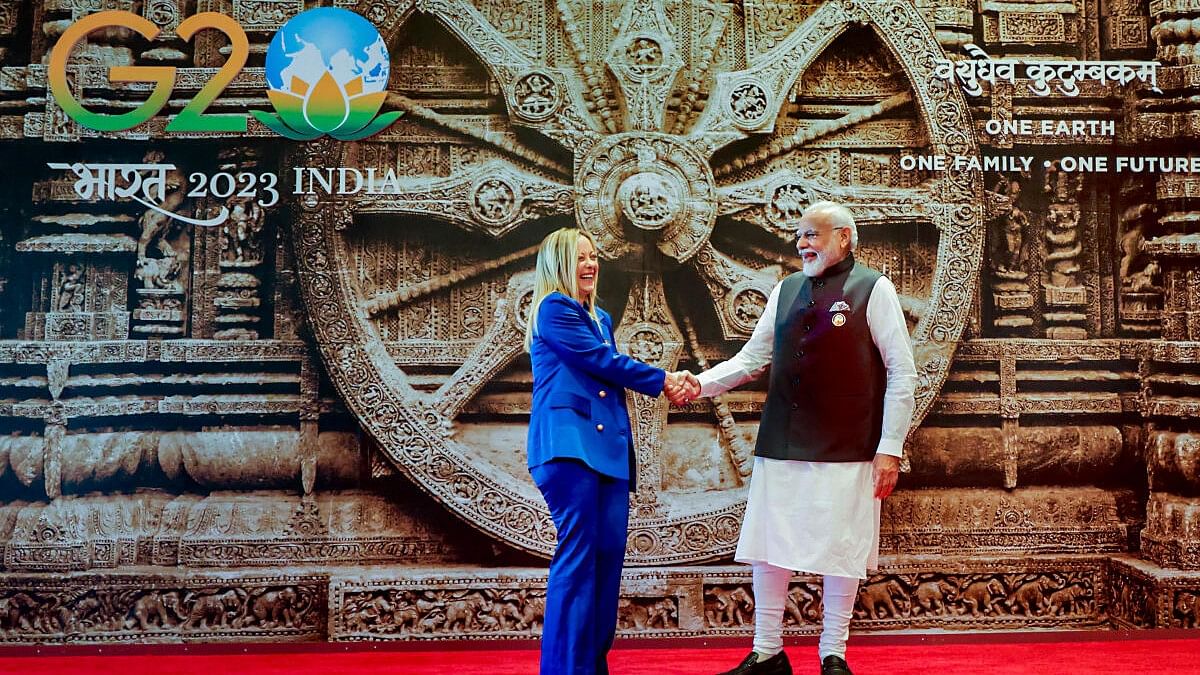
PM Narendra Modi shares a moment with Italian counterpart Giorgia Meloni upon her arrival at the G20 summit.
Credit: PTI Photo
It was Otto von Bismarck who commented prophetically that diplomacy always had politeness at its core. Even in the declaration of war, the German politician insisted, diplomacy required you to be polite. The other element that Bismarck perhaps didn’t bother with paying as much attention to, given the immensely big stick his country already wielded in global affairs at that time, was the need to back politeness up with branding.
We seem to have wielded this new tool, during the India presidency of the G20, especially during the just concluded G20 leaders’ summit in New Delhi. The fanfare that has followed, and the publicised hope that this may even eventually merit a Nobel Peace Prize, is proof that we’re insisting it’s feted as a pinnacle of diplomatic achievement. Understandably so. Given that we started almost with a cold start, and Prime Minister Narendra Modi had no real foreign policy credentials beyond visas denied while he was Chief Minister of Gujarat, we’ve indeed come a long way.
In today’s high-voltage multimedia world, it is impossible to practice and project yourself if you’re practising diplomacy with just the politeness schtick.
Today the artistry of diplomacy sinks unsung. Without big-time branding on the global stage, nothing is noticed. Today the accompaniments of diplomatic branding, as we practice it, is a rubric with the familiar three fundamental ‘Rs’ of branding: Repetition, Reputation, and Resources. Riding these steeds were Modi’s personally chosen band of three cowboys — his National Security Adviser, the External Affairs Minister, and, of course, his G20 Sherpa.
Without these, riding along, all the fine arts of arcane old-school Indian diplomacy would have been lost. In the high-pressure world of social media and 24X7 news cycles, even diplomats (and spooks) now know they live in a tone-deaf world. Often nothing short of screams and skirmishes make an impact. The soft sibilant sounds that diplomats are specialists at emitting, are no longer enough.
Branding is, therefore, the key. For example, the Bharat Mandapam, whether it got flooded or not, is an iconic testament to the kind of heft that only a country like India can afford to invest in and make an impact with. All this is expensive to the tune of five-figure crores of rupees and India’s entire diplomatic corps ran a 24X365 long campaign that repeated itself in every global capital, and Team Sherpa roused 77 cities across India rather insistently as no G20 had ever done before.
Diplomacy as historian Barbara Tuchman observed, today means "all the wicked devices of the Old World, spheres of influence, balances of power, secret treaties, triple alliances, and, during the interim period, appeasement of fascism.” While United States President Joe Biden may have blown sky high this force-fed appeasement, the queasy feeling lingers that appeasement was part of what was on full-blown display at the G20 Summit in New Delhi.
In India’s calculus, carping sounds don’t matter anymore. We’ve ‘diplomatically’ fought the good war, we’ve conquered new territories, including Africa, we’ve cocked a snook at China with a grand plan to run a new railway line to Europe, and we’ve even fronted a new global alliance in alternate fuels. Not too many leaders can lay claim to this kind of achievement. Certainly, Modi isn’t one to allow defunct laws of old-style diplomacy to dictate how this gets played out, domestically and globally. Branding, broadcast, and balloons…those are the things to watch for.
(Dilip Cherian, founding partner of Perfect Relations, is a public affairs consultant and branding strategist. Twitter: @DILIPtheCHERIAN)
Disclaimer: The views expressed above are the author's own. They do not necessarily reflect the views of DH.